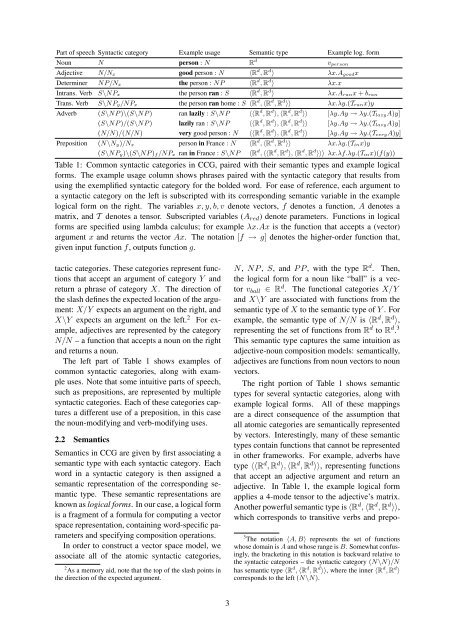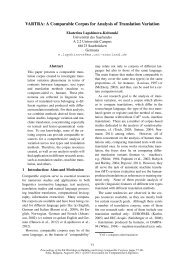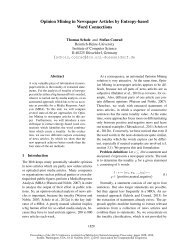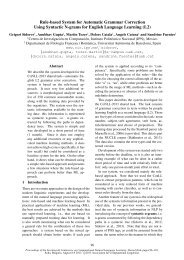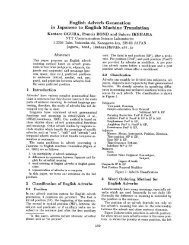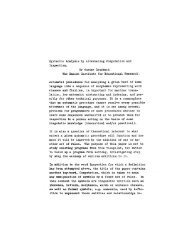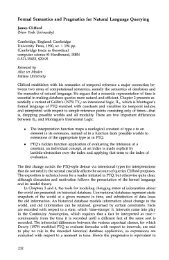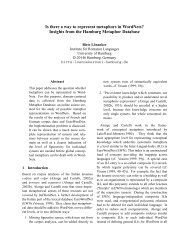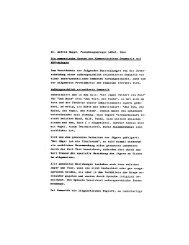Vector Space Semantic Parsing: A Framework for Compositional ...
Vector Space Semantic Parsing: A Framework for Compositional ...
Vector Space Semantic Parsing: A Framework for Compositional ...
You also want an ePaper? Increase the reach of your titles
YUMPU automatically turns print PDFs into web optimized ePapers that Google loves.
Part of speech Syntactic category Example usage <strong>Semantic</strong> type Example log. <strong>for</strong>m<br />
Noun N person : N R d v person<br />
Adjective N/N x good person : N 〈R d , R d 〉 λx.A good x<br />
Determiner NP/N x the person : NP 〈R d , R d 〉 λx.x<br />
Intrans. Verb S\NP x the person ran : S 〈R d , R d 〉 λx.A ranx + b ran<br />
Trans. Verb S\NP y/NP x the person ran home : S 〈R d , 〈R d , R d 〉〉 λx.λy.(T ranx)y<br />
Adverb (S\NP )\(S\NP ) ran lazily : S\NP 〈〈R d , R d 〉, 〈R d , R d 〉〉 [λy.Ay → λy.(T lazy A)y]<br />
(S\NP )/(S\NP ) lazily ran : S\NP 〈〈R d , R d 〉, 〈R d , R d 〉〉 [λy.Ay → λy.(T lazy A)y]<br />
(N/N)/(N/N) very good person : N 〈〈R d , R d 〉, 〈R d , R d 〉〉 [λy.Ay → λy.(T veryA)y]<br />
Preposition (N\N y)/N x person in France : N 〈R d , 〈R d , R d 〉〉 λx.λy.(T inx)y<br />
(S\NP y)\(S\NP ) f /NP x ran in France : S\NP 〈R d , 〈〈R d , R d 〉, 〈R d , R d 〉〉〉 λx.λf.λy.(T inx)(f(y))<br />
Table 1: Common syntactic categories in CCG, paired with their semantic types and example logical<br />
<strong>for</strong>ms. The example usage column shows phrases paired with the syntactic category that results from<br />
using the exemplified syntactic category <strong>for</strong> the bolded word. For ease of reference, each argument to<br />
a syntactic category on the left is subscripted with its corresponding semantic variable in the example<br />
logical <strong>for</strong>m on the right. The variables x, y, b, v denote vectors, f denotes a function, A denotes a<br />
matrix, and T denotes a tensor. Subscripted variables (A red ) denote parameters. Functions in logical<br />
<strong>for</strong>ms are specified using lambda calculus; <strong>for</strong> example λx.Ax is the function that accepts a (vector)<br />
argument x and returns the vector Ax. The notation [f → g] denotes the higher-order function that,<br />
given input function f, outputs function g.<br />
tactic categories. These categories represent functions<br />
that accept an argument of category Y and<br />
return a phrase of category X. The direction of<br />
the slash defines the expected location of the argument:<br />
X/Y expects an argument on the right, and<br />
X\Y expects an argument on the left. 2 For example,<br />
adjectives are represented by the category<br />
N/N – a function that accepts a noun on the right<br />
and returns a noun.<br />
The left part of Table 1 shows examples of<br />
common syntactic categories, along with example<br />
uses. Note that some intuitive parts of speech,<br />
such as prepositions, are represented by multiple<br />
syntactic categories. Each of these categories captures<br />
a different use of a preposition, in this case<br />
the noun-modifying and verb-modifying uses.<br />
2.2 <strong>Semantic</strong>s<br />
<strong>Semantic</strong>s in CCG are given by first associating a<br />
semantic type with each syntactic category. Each<br />
word in a syntactic category is then assigned a<br />
semantic representation of the corresponding semantic<br />
type. These semantic representations are<br />
known as logical <strong>for</strong>ms. In our case, a logical <strong>for</strong>m<br />
is a fragment of a <strong>for</strong>mula <strong>for</strong> computing a vector<br />
space representation, containing word-specific parameters<br />
and specifying composition operations.<br />
In order to construct a vector space model, we<br />
associate all of the atomic syntactic categories,<br />
2 As a memory aid, note that the top of the slash points in<br />
the direction of the expected argument.<br />
N, NP , S, and P P , with the type R d . Then,<br />
the logical <strong>for</strong>m <strong>for</strong> a noun like “ball” is a vector<br />
v ball ∈ R d . The functional categories X/Y<br />
and X\Y are associated with functions from the<br />
semantic type of X to the semantic type of Y . For<br />
example, the semantic type of N/N is 〈R d , R d 〉,<br />
representing the set of functions from R d to R d . 3<br />
This semantic type captures the same intuition as<br />
adjective-noun composition models: semantically,<br />
adjectives are functions from noun vectors to noun<br />
vectors.<br />
The right portion of Table 1 shows semantic<br />
types <strong>for</strong> several syntactic categories, along with<br />
example logical <strong>for</strong>ms. All of these mappings<br />
are a direct consequence of the assumption that<br />
all atomic categories are semantically represented<br />
by vectors. Interestingly, many of these semantic<br />
types contain functions that cannot be represented<br />
in other frameworks. For example, adverbs have<br />
type 〈〈R d , R d 〉, 〈R d , R d 〉〉, representing functions<br />
that accept an adjective argument and return an<br />
adjective. In Table 1, the example logical <strong>for</strong>m<br />
applies a 4-mode tensor to the adjective’s matrix.<br />
Another powerful semantic type is 〈R d , 〈R d , R d 〉〉,<br />
which corresponds to transitive verbs and prepo-<br />
3 The notation 〈A, B〉 represents the set of functions<br />
whose domain is A and whose range is B. Somewhat confusingly,<br />
the bracketing in this notation is backward relative to<br />
the syntactic categories – the syntactic category (N\N)/N<br />
has semantic type 〈R d , 〈R d , R d 〉〉, where the inner 〈R d , R d 〉<br />
corresponds to the left (N\N).<br />
3


